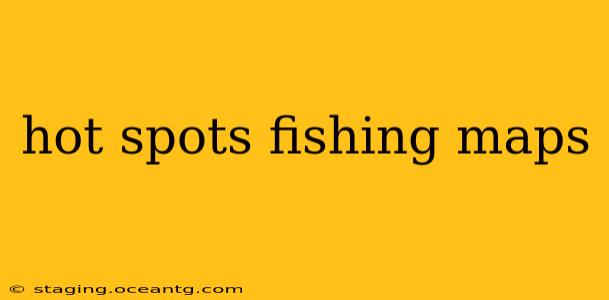Finding the perfect fishing spot can feel like searching for a needle in a haystack. But with the right tools and knowledge, you can significantly increase your chances of a successful fishing trip. This guide explores the world of hot spots fishing maps, revealing how they work, where to find them, and how to use them effectively to maximize your catch.
What are Hot Spots Fishing Maps?
Hot spots fishing maps are specialized maps that pinpoint areas with a high concentration of fish. These aren't your average topographical maps; they go beyond simple water depth and contour lines. Instead, they incorporate crucial data points that indicate where fish are likely to congregate. This data often includes:
- Depth contours: Showing the underwater terrain, crucial for identifying drop-offs, ledges, and other fish-holding structures.
- Bottom composition: Identifying areas with gravel, sand, mud, or vegetation, each preferred by different species.
- Structure markers: Highlighting submerged objects like wrecks, reefs, and artificial structures that attract fish.
- Water temperature variations: Showing thermal breaks, where warmer and cooler water meet, often attracting feeding fish.
- Current flow: Indicating areas with strong currents, which can bring in baitfish and larger predatory species.
- Historical fish catches: Based on user-submitted data, these pinpoint areas where anglers have previously had success.
Where to Find Hot Spots Fishing Maps?
Several resources offer hot spots fishing maps, each with its own strengths and weaknesses:
-
Online Mapping Services: Many online platforms, like Google Maps, integrate user-submitted data and fishing reports to create dynamic maps showing popular fishing spots. These are often free to use but might lack detailed information.
-
Specialized Fishing Apps: Numerous apps are dedicated to fishing, providing detailed maps, real-time fishing reports, and community features. These often require subscriptions but provide much more comprehensive data and functionality. Examples include Fishidy, Navionics, and Fishing Points.
-
Printed Charts and Guides: Traditional paper maps and fishing guides offer a more tangible approach. These are often specific to a particular lake, river, or region and might contain valuable local knowledge.
-
Local Bait Shops and Tackle Stores: These often have local knowledge of the best fishing spots in the area and may sell maps or offer advice.
How to Use Hot Spots Fishing Maps Effectively?
Using a hot spots fishing map effectively requires more than just identifying marked spots. Here's a breakdown of essential strategies:
-
Understand the Map's Data: Familiarize yourself with the symbols and legends used on the map. Different colors, lines, and symbols represent varying depths, structures, and other crucial information.
-
Consider the Time of Year and Weather: Fish behavior changes with the seasons and weather conditions. A hot spot during summer might be unproductive in winter. Check weather forecasts and consider seasonal fish migration patterns.
-
Look for Convergence Zones: These are areas where different environmental factors converge, often creating ideal feeding grounds. For example, where a drop-off meets a current break or where warmer and cooler water meet.
-
Combine Map Data with Local Knowledge: Supplement map data with information from local anglers, bait shops, or online forums. Local knowledge can often provide valuable insights not found on maps.
-
Respect Regulations and Leave No Trace: Always adhere to local fishing regulations, including size and bag limits. Practice responsible fishing and leave the area cleaner than you found it.
What are the best fishing spots near me?
This question is best answered using one of the map resources mentioned above. Enter your location and search for nearby fishing spots, taking into account the time of year and type of fish you are targeting.
Are fishing hot spot maps accurate?
The accuracy of fishing hot spot maps varies. Maps based on user-submitted data can be affected by the reliability of the information provided. Maps incorporating more scientific data, like depth contours and water temperature, tend to be more accurate. It's always a good idea to use multiple resources and combine map information with local knowledge.
How do I find good fishing spots without a map?
While maps are incredibly helpful, finding good fishing spots without a map is entirely possible. Observe the water's edge for signs of fish activity, such as birds diving or fish jumping. Look for areas with structure, such as drop-offs, submerged vegetation, or overhanging trees. Experiment with different locations and techniques to discover your own hidden gems.
By utilizing hot spots fishing maps strategically and combining their information with local knowledge and responsible fishing practices, you can significantly improve your chances of a rewarding and successful fishing experience. Remember that continuous learning and adapting to changing conditions are key to consistent success in angling.
